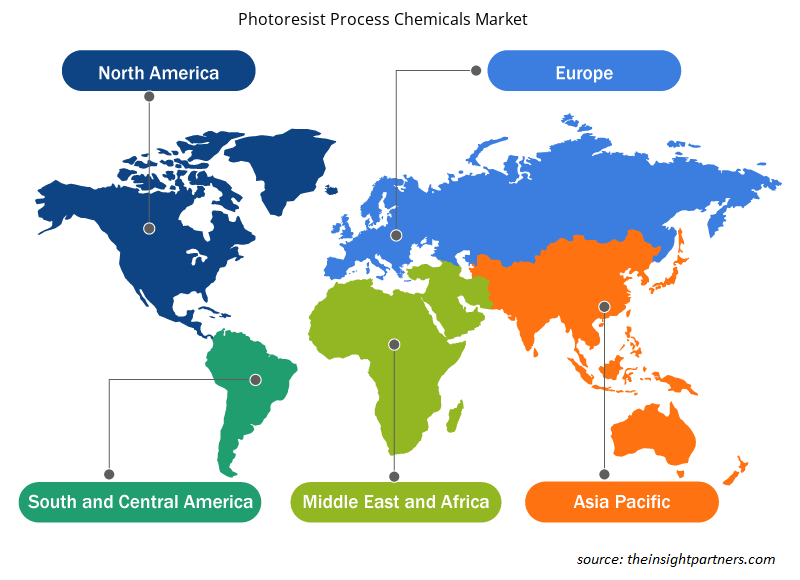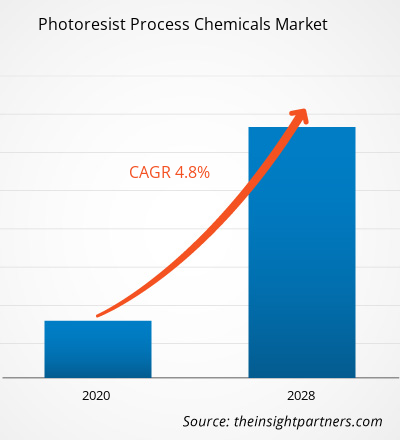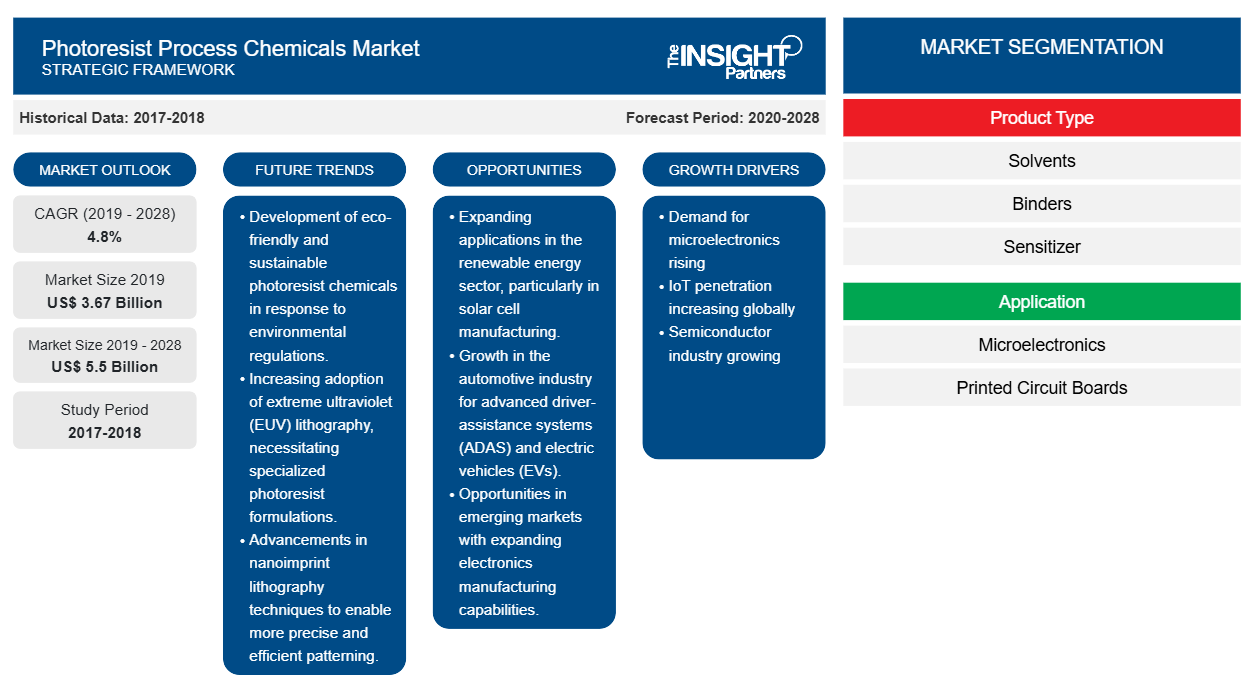Der Markt für Prozesschemikalien für Fotolacke hatte im Jahr 2019 einen Wert von 3.665,31 Millionen US-Dollar und dürfte im Zeitraum 2020–2028 mit einer durchschnittlichen jährlichen Wachstumsrate von 4,8 % wachsen und bis 2028 einen Wert von 5.495,02 Millionen US-Dollar erreichen.
Prozesschemikalien für Fotolacke werden bei der Herstellung von µm- und Sub-µm-Strukturen verwendet, insbesondere in der Mikroelektronikindustrie. Prozesschemikalien für Fotolacke umfassen Lösungsmittel, Entwickler, Entferner, Stripper und Ätzmischungen und gelten als grundlegender Bestandteil bei der Herstellung von Hochleistungsleiterplatten und Halbleiterchips. Das Wachstum des globalen Marktes für Prozesschemikalien für Fotolacke wird durch die kontinuierliche und stetige Nachfrage nach Mikroelektronik aufgrund der steigenden Nachfrage nach elektronischen Artikeln in Entwicklungsländern und der zunehmenden Verbreitung des IoT auf der ganzen Welt vorangetrieben. Darüber hinaus treiben Faktoren wie die steigende Nachfrage nach dynamischer Displaytechnologie und übermäßige F&E in den Prozesschemikalien für Fotolacke und ihren Endverbrauchsindustrien das Wachstum des globalen Marktes für Prozesschemikalien für Fotolacke voran.
Im Jahr 2019 hatte der asiatisch-pazifische Raum den größten Anteil am globalen Markt für Prozesschemikalien für Fotolacke. Der asiatisch-pazifische Raum wird in den kommenden Jahren voraussichtlich auch der am schnellsten wachsende Markt für Prozesschemikalien für Fotolacke sein. Der asiatisch-pazifische Raum ist der größte Kontinent der Welt und bekannt für seinen expandierenden Markt für chemische Produkte. Die Region gilt als einer der führenden Märkte für die Verwendung von Fotolacken und Fotolackzubehör und bietet daher lukrative Möglichkeiten für das Marktwachstum. China dominiert den regionalen Markt, gefolgt von Japan, Taiwan, Vietnam, Korea, Thailand, Malaysia und Indonesien. Diese Länder verzeichnen eine steigende Nachfrage von Herstellern von Halbleitern und ICs, LCDs, Leiterplatten und anderen. Prozesschemikalien für Fotolacke werden in großem Umfang bei der Herstellung von Fotolacken verwendet, die anschließend in tragbaren Geräten, Smartphones und anderen elektronischen Geräten verwendet werden. Zusammen mit einer Veränderung des Lebensstandards der Verbraucher ist die Nachfrage nach Smartphones und tragbaren Geräten mit dem Wachstum der Elektronikindustrie gestiegen. Diese Veränderung hat das Wachstum des Marktes für Prozesschemikalien für Fotolacke in der Region vorangetrieben.
Die COVID-19-Pandemie wirkt sich aufgrund von Lockdowns, Reiseverboten und Betriebsschließungen negativ auf die Wirtschaft und Industrie in verschiedenen Ländern aus. Darüber hinaus behindern die von Ländern in Europa, Asien und Nordamerika verhängten weltweiten Reiseverbote die Möglichkeiten für geschäftliche Kooperationen und Partnerschaften. All diese Faktoren behindern die Chemie- und Materialindustrie, was das Wachstum des Marktes für Fotolack-Prozesschemikalien bremst.
Passen Sie diesen Bericht Ihren Anforderungen an
Sie erhalten kostenlose Anpassungen an jedem Bericht, einschließlich Teilen dieses Berichts oder einer Analyse auf Länderebene, eines Excel-Datenpakets sowie tolle Angebote und Rabatte für Start-ups und Universitäten.
-
Holen Sie sich die wichtigsten Markttrends aus diesem Bericht.Dieses KOSTENLOSE Beispiel umfasst eine Datenanalyse von Markttrends bis hin zu Schätzungen und Prognosen.
Markteinblicke
Wachstum der Halbleiterindustrie
Jüngste technologische Fortschritte haben die Bedeutung von Halbleitern in verschiedenen Branchen erhöht. Sie sind nicht nur ein wichtiger Bestandteil von Unterhaltungselektronik und Peripheriegeräten, sondern erfreuen sich in den letzten Jahren auch einer steigenden Nachfrage aus dem Automobilsektor. Nach einem Rückgang der Verkaufszahlen im Jahr 2019 verzeichnete die Halbleiterindustrie 2019 trotz der Probleme durch die COVID-19-Pandemie, die die Weltwirtschaft zum Stillstand brachte, ein positives Umsatzwachstum.
Darüber hinaus sind Halbleiter ein integraler Bestandteil der Technologie um uns herum und sie verstärken die technologischen Innovationen. Sie liefern die wesentlichen Technologien für die Geräte des täglichen Gebrauchs wie Fernseher, Computer und Mobilgeräte. Photoresist-Prozesschemikalien werden in der Halbleiterherstellung für die Photolithografie verwendet. Die Photolithografie war der Haupttreiber bei dem Bestreben, die Größe von Geräten und Geräten so weit wie möglich zu reduzieren. Aus diesem Grund ist auch die Nachfrage nach Photoresist-Prozesschemikalien weltweit stark gestiegen. Einige Unternehmen haben auch Pläne gemacht, ihre Produktion von Photoresists auszuweiten, um der wachsenden Nachfrage der Halbleiterindustrie gerecht zu werden. So kündigte Sumitomo Chemical im Februar 2021 die Erweiterung seiner Produktionskapazität für Photoresists für fortschrittliche Halbleiterprozesse, einschließlich Argonfluorid-(ArF)-Immersion und Extrem-Ultraviolett-(EUV)-Lithografie, durch die Installation neuer Produktionslinien in seinem Werk in Osaka (Konohana-ku, Osaka, Japan) an. Das Unternehmen plant, den Betrieb bis 2022 aufzunehmen.
Einblicke in Produkttypen
Basierend auf dem Produkttyp ist der globale Markt für Prozesschemikalien für Fotolacke in Lösungsmittel, Bindemittel, Sensibilisatoren und andere unterteilt. Das Lösungsmittelsegment war 2019 mit dem größten Anteil Marktführer. Ein Fotolack wird auch als Resist bezeichnet und ist eine lichtempfindliche Anwendung, die in verschiedenen Prozessen wie der Fotolithografie und der Fotogravur verwendet wird, hauptsächlich um eine gemusterte Beschichtung auf einer Oberfläche zu erzeugen.
Anwendungseinblicke
Basierend auf der Anwendung ist der globale Markt für Fotolack-Prozesschemikalien in Mikroelektronik, Leiterplatten und andere unterteilt. Im Jahr 2019 hatte das Segment Mikroelektronik den größten Marktanteil. Die Mikroelektronikgeräte bestehen aus Mikrohalbleitergeräten, Transistoren, Kondensatoren, Widerständen und aktiven Chips. Sie werden häufig in Unterhaltungselektronikgeräten wie Smartphones, Musikplayern und Haushaltsgeräten sowie in anderen industriellen Prozessen verwendet. Zu diesem Zweck werden Fotolacklösungsmittel, Sensibilisatoren, Polymere und andere Chemikalien verwendet. Zunehmende Anwendungen in der Medizin-, Automobil- und Elektronikindustrie haben die Nachfrage nach mikroelektronischen Komponenten erhöht, was das Wachstum des Marktes für Fotolack-Prozesschemikalien unterstützt.
Tokyo Ohka Kogyo Co., Ltd.; Tokuyama Corporation; Dupont; Integrated Micro Materials; Allresist Gmbh; Microchemicals Gmbh; Dischem Inc; ENF TECHNOLOGY CO., LTD.; Sumitomo Chemical Co., Ltd; und Prolyx Microelectronics Private Limited gehören zu den wichtigsten Marktteilnehmern auf dem Markt für Prozesschemikalien für Fotolacke. Diese Unternehmen bieten ihre Produkte weltweit an, was ihnen hilft, eine breitere Kundenbasis zu bedienen. Diese großen Marktteilnehmer konzentrieren sich stark auf die Entwicklung qualitativ hochwertiger und innovativer Produkte, um die Anforderungen der Kunden zu erfüllen. In den letzten Jahren haben die auf dem Markt tätigen Unternehmen das enorme Potenzial des Marktes für Prozesschemikalien für Fotolacke erkannt und waren stark an Strategien wie Fusionen und Übernahmen sowie Produkteinführungen beteiligt. So wurden beispielsweise im Jahr 2019 die Photoresist Stripper SVD und SH5 von der Microchemicals Gmbh auf den Markt gebracht. Diese Stripper entfernen effizient Fotolackschichten von anorganischen Substraten wie Silizium, Glas und Metallen.
Bericht-Spotlights
- Fortschrittliche Branchentrends auf dem globalen Markt für Photoresist-Prozesschemikalien helfen den Akteuren bei der Entwicklung wirksamer langfristiger Strategien
- In Industrie- und Entwicklungsländern angewandte Strategien für Unternehmenswachstum
- Quantitative Analyse des globalen Marktes für Photoresist-Prozesschemikalien von 2018 bis 2028
- Schätzung der Nachfrage nach Photoresist-Prozesschemikalien in verschiedenen Branchen
- PEST-Analyse zur Veranschaulichung der Wirksamkeit der in der Branche tätigen Käufer und Lieferanten bei der Vorhersage des Marktwachstums
- Aktuelle Entwicklungen zum Verständnis des Wettbewerbsmarktszenarios und der Nachfrage nach Fotolack-Prozesschemikalien
- Markttrends und -aussichten in Verbindung mit Faktoren, die das Wachstum des Marktes für Photoresist-Prozesschemikalien vorantreiben und bremsen
- Entscheidungsprozess durch das Verständnis von Strategien, die das kommerzielle Interesse im Hinblick auf das Wachstum des globalen Marktes für Photoresist-Prozesschemikalien untermauern
- Marktgröße für Photoresist-Prozesschemikalien an verschiedenen Marktknoten
- Detaillierte Übersicht und Segmentierung des globalen Marktes für Photoresist-Prozesschemikalien sowie seiner Dynamik in der Branche
- Marktgröße für Fotolack-Prozesschemikalien in verschiedenen Regionen mit vielversprechenden Wachstumschancen
Regionale Einblicke in den Markt für Photoresist-Prozesschemikalien
Die regionalen Trends und Faktoren, die den Markt für Photoresist-Prozesschemikalien während des gesamten Prognosezeitraums beeinflussen, wurden von den Analysten von Insight Partners ausführlich erläutert. In diesem Abschnitt werden auch die Marktsegmente und die Geografie von Photoresist-Prozesschemikalien in Nordamerika, Europa, im asiatisch-pazifischen Raum, im Nahen Osten und Afrika sowie in Süd- und Mittelamerika erörtert.

- Erhalten Sie regionale Daten zum Markt für Photoresist-Prozesschemikalien
Umfang des Marktberichts zu Photoresist-Prozesschemikalien
| Berichtsattribut | Details |
|---|---|
| Marktgröße im Jahr 2019 | 3,67 Milliarden US-Dollar |
| Marktgröße bis 2028 | 5,5 Milliarden US-Dollar |
| Globale CAGR (2019 - 2028) | 4,8 % |
| Historische Daten | 2017-2018 |
| Prognosezeitraum | 2020–2028 |
| Abgedeckte Segmente |
Nach Produkttyp
|
| Abgedeckte Regionen und Länder |
Nordamerika
|
| Marktführer und wichtige Unternehmensprofile |
|
Dichte der Marktteilnehmer für Photoresist-Prozesschemikalien: Verständnis ihrer Auswirkungen auf die Geschäftsdynamik
Der Markt für Photoresist-Prozesschemikalien wächst rasant, angetrieben durch die steigende Endverbrauchernachfrage aufgrund von Faktoren wie sich entwickelnden Verbraucherpräferenzen, technologischen Fortschritten und einem größeren Bewusstsein für die Vorteile des Produkts. Mit steigender Nachfrage erweitern Unternehmen ihr Angebot, entwickeln Innovationen, um die Bedürfnisse der Verbraucher zu erfüllen, und nutzen neue Trends, was das Marktwachstum weiter ankurbelt.
Die Marktteilnehmerdichte bezieht sich auf die Verteilung der Firmen oder Unternehmen, die in einem bestimmten Markt oder einer bestimmten Branche tätig sind. Sie gibt an, wie viele Wettbewerber (Marktteilnehmer) in einem bestimmten Marktraum im Verhältnis zu seiner Größe oder seinem gesamten Marktwert präsent sind.
Die wichtigsten auf dem Markt für Photoresist-Prozesschemikalien tätigen Unternehmen sind:
- Tokio Ohka Kogyo Co., Ltd.
- Tokuyama Corporation
- Dupont
- Integrierte Mikromaterialien
- Allresist GmbH
Haftungsausschluss : Die oben aufgeführten Unternehmen sind nicht in einer bestimmten Reihenfolge aufgeführt.

- Überblick über die wichtigsten Akteure auf dem Markt für Photoresist-Prozesschemikalien
Markt für Photoresist-Prozesschemikalien nach Produkttyp
- Lösungsmittel
- Bindemittel
- Sensibilisator
- Sonstiges
Markt für Photoresist-Prozesschemikalien, nach Anwendung
- Mikroelektronik
- Leiterplatten
- Sonstiges
Firmenprofile
- Tokio Ohka Kogyo Co., Ltd.
- Tokuyama Corporation
- Dupont
- Integrierte Mikromaterialien
- Allresist GmbH
- Microchemicals GmbH
- Dischem Inc
- ENF TECHNOLOGY CO., LTD.
- Sumitomo Chemical Co., Ltd
- Prolyx Microelectronics Private Limited
- Historische Analyse (2 Jahre), Basisjahr, Prognose (7 Jahre) mit CAGR
- PEST- und SWOT-Analyse
- Marktgröße Wert/Volumen – Global, Regional, Land
- Branchen- und Wettbewerbslandschaft
- Excel-Datensatz
Aktuelle Berichte
Verwandte Berichte
Erfahrungsberichte
Grund zum Kauf
- Fundierte Entscheidungsfindung
- Marktdynamik verstehen
- Wettbewerbsanalyse
- Kundeneinblicke
- Marktprognosen
- Risikominimierung
- Strategische Planung
- Investitionsbegründung
- Identifizierung neuer Märkte
- Verbesserung von Marketingstrategien
- Steigerung der Betriebseffizienz
- Anpassung an regulatorische Trends























 Kostenlose Probe anfordern für - Markt für Photoresist-Prozesschemikalien
Kostenlose Probe anfordern für - Markt für Photoresist-Prozesschemikalien